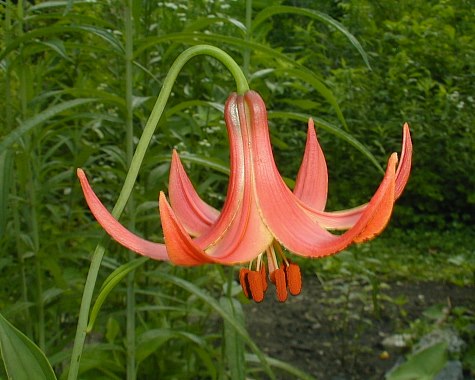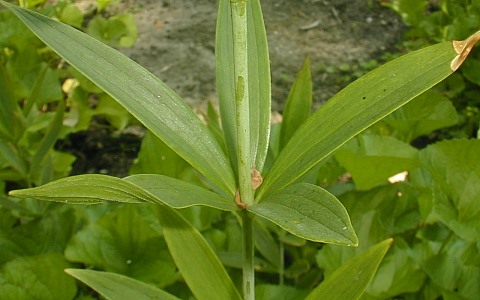Description: This perennial wildflower is 2-4' tall and unbranched, except near the apex where the flowers occur. The central stem is light green, terete, glabrous, and often glaucous. At intervals along this stem, there are whorls of 3-8 leaves; 1 or 2 alternate leaves may occur along the upper portion of the stem. These leaves are up to 6" long and 1" across, narrowly ovate, smooth along the margins, and sessile. The upper surface of each leaf is medium to dark green and glabrous, while the lower surface is a lighter shade of green with finely short-pubescent hairs along the veins (a 10x hand lens may be necessary to see these minute hairs). The veins of the leaves are parallel. The upper stem terminates in 1-5 (rarely up to 20) yellow-orange to red-orange flowers on long stalks. Each of these stalks nods downward at its apex. Some stalks may have 1 or 2 leafy bracts that resemble the leaves, except they are smaller in size. Each trumpet-shaped flower is about 2½" long and across, consisting of 6 tepals, 6 stamens with red anthers, and a central pistil. The throat of the flower becomes yellow and it has purple dots. The tips of the tepals curve backward, but they don't extend to the base of the flower. The anthers and style of each flower are exerted only slightly from the corolla (the 6 tepals). The blooming period occurs from late spring to mid-summer and lasts about 3 weeks. There is no noticeable floral scent. Each fertile flower is replaced by an oblongoid seed capsule that is about 2" long. Each seed capsule is divided into 3 cells; within each cell, there is a stack of large flattened seeds. The root system consists of a scaly corm with fibrous roots. This wildflower reproduces by seed or from offsets of the corms.

Cultivation:
The
preference is dappled sunlight or partial sun, moist to mesic
conditions, and a rich loamy or slightly sandy soil. The number of
flowers on each plant is variable.
Range & Habitat:
Canada Lily has not been found in Illinois as either a native plant or
an escaped cultivated plant. However, it occurs as a native plant in
Indiana, thus it is possible that this species may establish itself in
Illinois in the future. In Indiana and other eastern states, Canada
Lily is found in open woodlands, wooded slopes, savannas, woodland
openings, and moist meadows. Like other Lilium spp.
(lilies), it is cultivated in gardens because of the large showy
flowers.
Faunal Associations:
The floral nectar attracts large butterflies, particularly Speyeria
cybele (Great Spangled Fritillary) and various Swallowtail
butterflies. Halictid bees (e.g., Lasioglossum spp.)
collect pollen from the flowers, but they are ineffective at
cross-pollination because of their small size. The caterpillars of Papaipema
nebris (Common Borer Moth), Papaipema cataphracta
(Burdock Borer Moth), and Papaipema cerina (Golden
Borer Moth) bore through the stems of native Lilium spp.
(lilies). The last of these three species is oligophagous (specialist
feeder). Other insects that feed on native lilies include Acrolepiopsis
incertella (Carrion Flower Moth; caterpillars bore into corms
or stems of lilies), Merodon equestris (Narcissus
Bulb Fly; maggots feed on corms), and the introduced Lilioceris
lilii (Lily Leaf Beetle; feeds on leaves). The Lily Leaf
Beetle occurs in some northeastern states, but it has not been observed
in Illinois thus far. Deer, rabbits, and other mammalian herbivores
readily browse on the foliage of native Lilies, while voles and
chipmunks eat the corms.

Photographic
Location:
A garden in Urbana, Illinois.
Comments:
This attractive lily is similar to other lilies with orange flowers,
including Lilium superbum (Turk's Cap Lily), Lilium
michiganense (Michigan Lily), and the introduced Lilium
lancifolium (Tiger Lily). Like the flowers of Canada Lily,
the flowers of Michigan Lily and Turk's Cap Lily often nod downward.
However, the tepal tips of Michigan Lily curve back to the base of the
flower, while the tepal tips of Turk's Cap Lily curve back and extend
behind the base of the flower. The tepal tips of Canada Lily, in
contrast, curve back only a little and remain in front of the base of
the flower. The introduced Tiger Lily, in contrast to these native
lilies, has dark bulbets in the axils of its leaves along the central
stem, and its leaves are alternate (rather than whorled). Other
orange-flowered lilies, whether native or introduced, typically have
erect flowers. Of these various species, you are most likely to
encounter the Michigan Lily in the natural areas of Illinois, although
the Tiger Lily has become increasingly common.